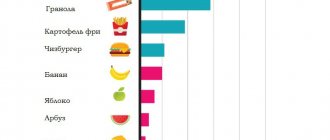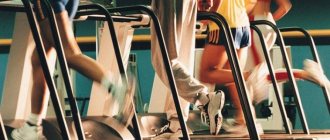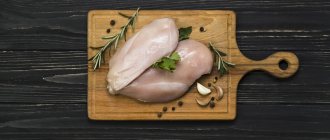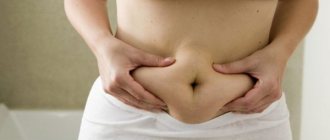Degrees of abdominal deformation Indications and contraindications for panniculectomy Preparation Progress of the operation Results and rehabilitation period
The adipose apron is a large excess of skin and fat localized on the anterior abdominal wall. It is characterized by pronounced ptosis (drooping) of soft tissues. It is not only an aesthetic defect. If the skin-fat fold sags to the level of the hips, diaper rash, irritation, itching occur, weeping ulcers can form, an unpleasant odor appears, and there is a high risk of eczema.
Most often, the problem of the appearance of an apron is faced by people (both women and men equally) who have lost significant weight or those whose weight often fluctuates in one direction or another - this causes deformation of the abdominal muscles. In women, such a defect can be provoked by pregnancy: while carrying a child, the rectus abdominis muscles may separate, which will cause prolapse of the anterior abdominal wall.
You can’t get rid of sagging skin with diets and exercises. The problem can only be solved with the help of panniculectomy - a surgical operation to remove the abdominal apron (its name comes from the Latin word pannus - “apron”).
Panniculectomy is the only method of combating ptosis of the skin-fat structure. For example, liposuction is a way to simply pump out fat. In addition, panniculectomy should not be confused with abdominoplasty. The latter involves not only removing fat and skin, but also lifting muscles. When correcting the apron, you can combine these types of plastic surgery.
Degrees of abdominal deformation
Before surgically removing excess skin and fat tissue, the plastic surgeon assesses the degree of abdominal deformation. The more pronounced the changes, the more difficult the operation will be.
| Deformation degree | To what level does the skin-fat apron reach? |
| I | Pubic hairline |
| II | External genitalia |
| III | Upper thigh |
| IV | Mid thigh |
| V | Knees |
Self-massage of the abdomen: removing the fat apron
Now we remove the fat apron with self-massage of the abdomen, which is recommended to be performed several times a week. The correct technique is very important here, otherwise you will not only not get results, but you may also harm yourself. The massage technique looks like this:
- The massage should only be done while standing. First, thoroughly warm up the desired area by intensively stroking the abdomen with your palm in a clockwise direction. Movements should be gentle.
- Now let's start kneading. The fat fold is collected between the fingers and pulled back. Then you need to roll it over the entire area.
- Rubbing the belly. Using your palms or the edges of your palms, rub the surface intensively. Alternate the movements several times.
To make the massage more effective, you can use massage creams and oils. A video of self-massage of the abdomen will also help you to remove the fat apron.
Indications and contraindications for panniculectomy
The indication for the procedure is the presence of a skin-fat apron. It is important that the patient’s weight is stabilized before the intervention. If further weight loss is planned, the problem may return, and the effect of the operation will disappear.
Panniculectomy is a traumatic and complex operation, so there are many contraindications to it. Intervention is not carried out in the following cases:
- hypertension;
- infectious diseases;
- chronic diseases in the acute stage;
- blood clotting disorder;
- obesity;
- diabetes mellitus and other diseases of the endocrine system;
- oncology;
- autoimmune diseases;
- problems with the cardiovascular system;
- liver and kidney failure;
- any diseases of internal organs.
Why does an “apron” of fat appear and why is it dangerous?
After childbirth, especially if the stork gave the mother a large baby or twins, the abdominal wall often remains ugly, covered with stretch marks. Severe tissue overstretching cannot always be eliminated with physical exercise and massage. Skin-fat deformation also appears in obese people. Apron-like folds can hang down to the genitals or even below. The problem occurs not only in women, but also in men, sometimes acquiring monstrous proportions. A case is described when, during an operation, doctors removed a 60-kilogram “apron” from a patient. Another reason for the appearance of folds on the stomach is excess skin left after losing weight and disfiguring the figure.
Unfortunately, this problem is not only aesthetic. Microbes accumulate in the folds of the “apron”, causing irritation, diaper rash, skin diseases and causing an unpleasant odor. Hernias occur on the overstretched anterior abdominal wall.
Large skin aprons cause:
- spinal overstrain;
- congestion in blood vessels;
- varicose veins; swelling of the legs.
Abdominoplasty will relieve all these problems, restoring the aesthetic appearance of the abdomen. The name of the operation comes from the Greek abdomen - belly.
Preparation
Long before surgery, the patient should stabilize his weight and improve his overall health. For several months before surgical removal of the abdomen, you need to adhere to a low-calorie diet plan, food should be rich in microelements and vitamins. In addition to the diet, it is recommended to engage in physical exercise to strengthen the muscle frame.
For 2 weeks, you must stop smoking, alcoholic beverages, blood thinners and contraceptives that cause blood clots.
Nicotine impedes the healing process, and the presence of alcohol in the blood reduces its coagulability. These factors have a major impact when planning such a complex and large-scale intervention.
7-10 days before the operation, you need to undergo an examination: take blood and urine tests, do an ECG and fluorography, as well as other studies as prescribed by the doctor. The patient should consult with an anesthesiologist and therapist.
On the day of surgery, you cannot use decorative and skincare cosmetics; women need to remove nail polish. It is necessary to carry out hygiene procedures and remove hair in the area of the operation.
Why are people afraid of abdominoplasty?
It is no secret that some people are suspicious of abdominoplasty, considering it difficult and risky. This is completely justified. If the operation is performed incorrectly, patients may experience fistulas and fluid accumulation in the area of the postoperative suture, muscle weakening, bleeding, and even recurrent hernias. Contacting a competent and specialist, such as plastic surgeon S. Morozov, who has extensive experience in performing abdominoplasty on men and women, will also help to avoid this.
The patient is hospitalized in a modern clinic and operated on using modern technologies, which ensures a quick recovery. For each patient, doctor S. Morozov draws up an individual treatment plan aimed at maximizing the improvement of the figure. A year later, thin sutures above the pubis and in the umbilical area remind of the operation. Patients are delighted with the results obtained, getting a beautiful and toned figure and getting rid of complexes.
Return to list
Progress of the operation
Panniculectomy is performed under general anesthesia. Its duration can reach 8 hours, depending on the complexity and scale of the manipulations.
Typically, two incisions are made:
- horizontal (in the pubic area, from which excess skin and adipose tissue is removed);
- vertical (from the lower border of the sternum to the pubic bone).
After removing the skin-fat apron, the boundaries of the incisions are sutured layer by layer, and a drainage tube is installed.
Diastasis (divergence) of the rectus abdominis muscles can be eliminated at the same time.
Abdominoplasty: types
When selecting the most suitable method of surgical intervention for each specific case, the surgeon takes into account the following nuances: the general health of the patient, the thickness of the fat layer, the tone of the muscles of the anterior abdominal wall and the degree of elasticity of the skin.
Abdominoplasty is recommended for sagging tissue in the abdominal area. For patients who have pronounced age-related changes or significant tissue sagging after a sharp decrease in body weight, it is advisable to undergo a comprehensive body lift - body lifting.
The main types of abdominoplasty used for surgical correction of the abdomen in modern plastic surgery include:
- classical abdominoplasty with relocation of the navel - indications for the use of this technique are: pronounced prolapse of tissues, divergence of the rectus abdominal muscles, hernias. A surgical incision is made in the lower abdomen and around the navel, peeling off all the tissue of the abdominal wall. Excess skin and subcutaneous fat deposits are removed, the tissues of the upper abdomen are stretched, the navel is moved to a new location and sutures are applied. The average duration of the operation is three hours;
- mini abdominoplasty – if aesthetic defects are localized only under the navel, in the lower abdomen. In this case, the surgeon makes an incision in the suprapubic fold, after which he removes excess skin and fat deposits and tightens the muscles. The operation is performed without moving or plasticizing the navel. The stitches after miniabdominoplasty are small and unnoticeable. Mini abdominoplasty usually lasts no more than two hours;
- endoscopic abdominoplasty - this type of surgical correction is indicated if the patient has maintained a normal degree of skin elasticity and has mild muscle ptosis. Endoscopic abdominoplasty involves the insertion of a video camera and special surgical instruments through small punctures in the abdominal wall. During the operation, the surgeon tightens and sutures the muscles without touching the skin. As a rule, endoscopic abdominoplasty complements mini abdominoplasty. The duration of the procedure is from one and a half to two hours;
- plastic correction of the navel - intervention is necessary in the presence of a stretched or protruding navel, if the tone of the muscles of the abdominal wall is preserved and there is no excess skin and subcutaneous fat. The appearance of such an aesthetic defect is most often associated with pregnancy and childbirth or surgical interventions in the abdominal cavity. Thanks to umbilicoplasty, it is possible to restore the shape of the umbilical ring. The operation lasts about an hour.
The cost of abdominal abdominoplasty depends on the degree of neglect of the patient’s problem and the type of surgical correction.
Results and rehabilitation period
The operation allows you to completely remove the apron and give the figure a beautiful outline. The patient becomes slim and fit. The achieved result must be maintained by constantly monitoring your weight, eating right, and regularly performing moderate exercise. The scars from the incisions will turn white within a year and stop protruding above the skin, but will not disappear completely. They can be polished with a laser. On the 3-4th day after surgery, the drainage tube is removed.
In the first days, the patient is in the hospital because he requires effective pain relief and frequent dressing changes.
After returning home you need for 1-2 months:
- ensure peace of mind;
- minimize any physical activity;
- do not lift heavy objects (over 4 kg);
- wear a bandage or compression garment for 2 months (or another period recommended by your doctor) to stabilize the result.
In addition, during the recovery period the following is prohibited:
- overheat the intervention area - go to the bathhouse, sauna, take a hot bath;
- visit a public swimming pool;
- sunbathing - both under the sun and in a solarium;
- overeat.
The doctor may additionally prescribe physical therapy to speed up recovery and improve the quality of the skin in the intervention area.
To prevent complications, the doctor prescribes a course of antibiotics. In addition, each patient is recommended a course of treatment for dysbiosis, which can be caused by antibiotics.
When a noticeable fold forms on the stomach, which is called an “apron,” a person experiences complexes and discomfort. A panniculectomy can help, during which not only excess skin is removed, but also fat deposits.
Gvaramiya Eka Yurievna
Participant of congresses, conferences and seminars on plastic surgery. Priority areas: abdominoplasty, blepharoplasty, liposuction, reconstructive plastic surgery.
How to get rid of an apron on your stomach: exercises
As already mentioned, it is important for us to restore muscle tone, and for this we need special exercises aimed at correcting the lower abdomen and tightening the muscles. If you need to remove the apron from your stomach, the following exercises will help:
- You need to lie on your back, place your legs in a straight position on the floor, place your arms along your body. Alternately lift one and the other leg up, then lower them, also alternately. To increase the effectiveness of the exercise, you can not lower your legs completely, but keep them at a distance of 1-2 cm from the floor.
- To cope with how to remove an apron on your stomach, you can use a fitball or leg weights. You can do this exercise without weights, but with it its effectiveness increases. You need to lie on your back, place your hands on your head, and place your legs straight on the floor. Raise your legs so that your body forms a right angle. In this position, you need to lift your buttocks off the floor and raise your pelvis as high as possible. After this, return to the starting position.
- Another good exercise is bicycle crunches. You need to lie on your back, raise your legs and bend them at the knees. Place your hands behind your head, elbows out to the sides. Pull your left knee towards your chest and try to touch it with your right elbow. Then change arms and legs and repeat the exercise.
- You need to lie on your back, stretch your arms up along the floor, and keep your legs straight. Now simultaneously raise your torso and legs, trying to touch your heels with your palms.
Also, in the question of how to remove belly fat, cardio exercises - running, swimming, cycling - will be useful.
Breathing exercises will also help remove the apron on your stomach after a caesarean section. It helps to significantly reduce the size of your belly in just a couple of weeks. Pay attention to the following exercises:
- Torso rotations help - an effective exercise for the abdominal apron. Stand straight, place your hands in front of your chest, place your feet shoulder-width apart. When turning to the sides, pull in your stomach as much as possible, tensing your abdominal muscles. Returning to the starting position, exhale to completely free the stomach and chest from air. Do the exercise slowly, controlling your breathing.
- Get on all fours, resting on your elbows . Inhale for eight counts, drawing in your stomach as much as possible. Then exhale for eight counts, sticking out your stomach. When inhaling, the spine should assume an arched position.
- Lie on your back, bend your knees, and place your hands on your legs. Relax completely. Inhale slowly for ten counts, drawing in your stomach as much as possible. Now exhale, also slowly, drawing in your stomach even more.
Is it possible to remove the apron?
A sagging belly can be completely removed at the initial stage with the help of simple manipulations. If the apron is a constant companion for a long period, then it will be more difficult to get rid of it - all available means must be used, it is necessary to act comprehensively. Severely advanced cases, when sagging folds appear on the abdomen, can only be corrected through surgical intervention.










